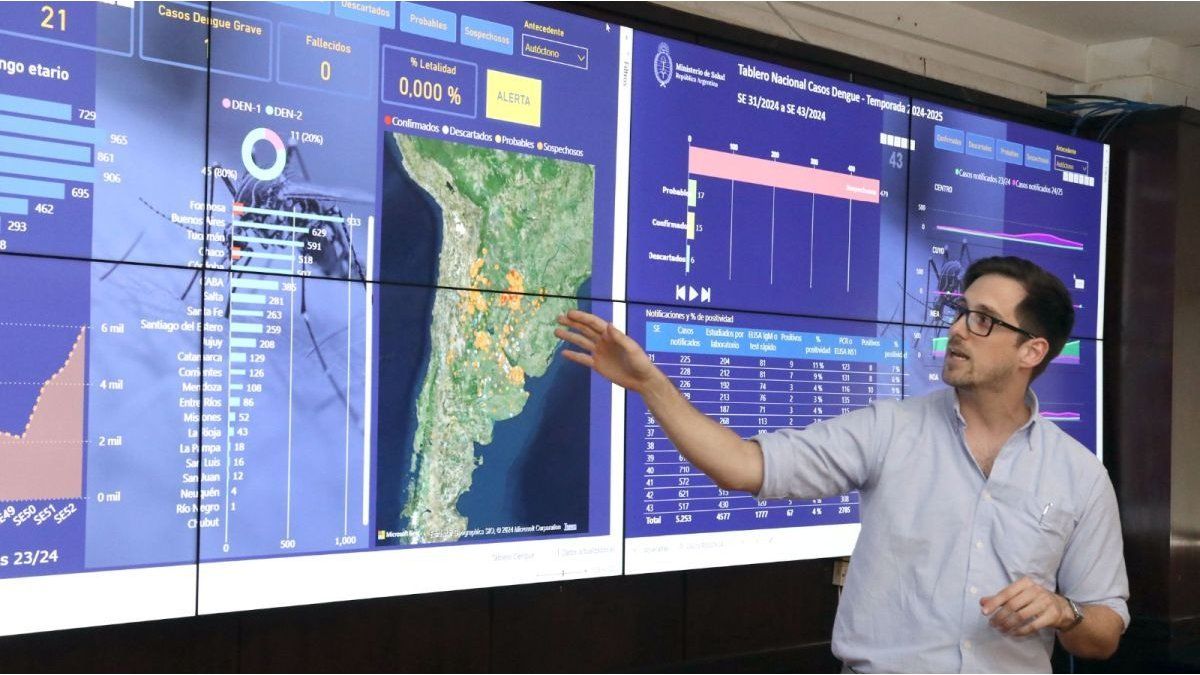He Ministry of Health of the Nation launched a situation room intended to optimize the monitoring of the dengue in Argentina. This innovation is part of the Strategic Plan for the Prevention and Control of Dengue 2024-2025, designed in collaboration with the 24 provinces of the country, and presents technological and methodological advances that facilitate intelligent data analysis, thus supporting strategic decisions in real time.
The presentation of the situation room was carried out by Mauro Bertolinidoctor of the Dengue Coordination Unit, who provided details about the operation of the new national dashboard. This tool will be available to health teams in each province, allowing them analyze the epidemiological situation in real time and compare information precisely at the jurisdictional and departmental level.
dengue.jpg
The use of the screen will allow the epidemiological situation to be analyzed in real time and thus make strategic decisions.
Courtesy of the National Ministry of Health
Responses according to each epidemiological situation
The board incorporates alert notification systems that are activated if a consecutive increase in suspected or confirmed cases is detected for three weeks. This early warning system will facilitate an immediate response to possible outbreaks, guaranteeing more effective coordination of preventive actions.
Presented at the last Federal Health Council (COFESA), this situation room becomes a key tool for decision making and planning strategic responses to dengue. Access to detailed data for each jurisdiction, locality and department will allow the national government to work together with the provinces to implement timely measures adapted to each epidemiological reality.
How the new situation room works
The situation room has a physical headquarters in the Ministry of Health of the Nation and virtual access for the rest of the provincial portfolios. In approximately one week, health teams in each province will have access to the platform. This room allows both visualize the current epidemiological situation and compare it with the same period last yearin which a historic outbreak was recorded. The data, provided by each jurisdiction through the National Surveillance System, is updated continuously.
The tool facilitates exhaustive monitoring of confirmed and serious cases and deaths, as well as jurisdictions with active notifications. According to Bertolini, the room not only allows manual monitoring, but also issues automatic alerts: a “yellow alert” is activated if an increase in suspected cases is detected for three consecutive weeks. On the other hand, a “red alert” signals increases in confirmed and probable cases, aiding rapid intervention in affected areas.
The methodology of this room allows a intelligent information analysis. According to the Ministry, this tool is no longer “a simple photo of the moment”, but rather offers the possibility of “democratize data”, by making accurate and accessible information available to health areas throughout the country.
Each user enabled in the system can customize the data display. This includes ffilters to select variables such as region (for example, the Cuyo region) and age group, which facilitates the adaptation of strategies at the local level, according to the specific needs of each jurisdiction.
Dengue: prevention measures
Health maintains that the most effective measure to stop the transmission of the disease is reduce mosquito populationsfor this it is necessary to eliminate all breeding sites, that is, all containers that contain water or that can do so. For this, it is necessary:
-
Eliminate all unused containers that can accumulate water: cans, bottles, tires, etc., inside and outside the home and/or workplace.
-
Turn, cover or protect useful objects that are outside and they can accumulate rainwater or irrigation: for example buckets, basins, drums, toys, etc.
-
Regularly brush, clean and change the water in animal drinkers every 2 or 3 dayscover and drain the air conditioning or rain drain collectors.
- Avoid plants in containers with water or change it frequently (every 2-3 days, with the same procedure as in the previous point).
- Replace water in pots or plant containers with sandpreventing a puddle from forming on top.
- Fill the pot holders with sand in order to absorb excess irrigation water.
- Maintain patios and gardens weeded.
- Unclog gutters and rain drains.
- Pour hot water (100°C) on the walls of drainage grates and place metal mesh or mosquito netting on them.
- Keep tanks and containers covered (citters, cisterns, etc.) that are used to collect and store water, avoiding leaving spaces or openings where mosquitoes can enter.
- Keep swimming pools clean and chlorinated. Cover them when not in use.
Source: Ambito
I am an author and journalist who has worked in the entertainment industry for over a decade. I currently work as a news editor at a major news website, and my focus is on covering the latest trends in entertainment. I also write occasional pieces for other outlets, and have authored two books about the entertainment industry.




